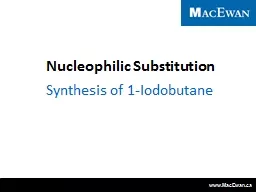

Synthesis of 1Iodobutane Nucleophilic Substitution of Alkyl Halides Synthesis of 1Iodobutane 1Bromobutane is a primary alkyl halide not sterically hindered Acetone is a polar aprotic solvent It poorly solvates the iodide nucleophile ID: 935506
Download Presentation The PPT/PDF document "Nucleophilic Substitution" is the property of its rightful owner. Permission is granted to download and print the materials on this web site for personal, non-commercial use only, and to display it on your personal computer provided you do not modify the materials and that you retain all copyright notices contained in the materials. By downloading content from our website, you accept the terms of this agreement.
Slide1
Nucleophilic Substitution
Synthesis of 1-Iodobutane
Slide2Nucleophilic Substitution of Alkyl Halides:
Synthesis of 1-Iodobutane
1-Bromobutane is a primary alkyl halide (not sterically hindered).
Acetone is a polar aprotic solvent. It poorly solvates the iodide nucleophile, promoting the SN2 mechanism.Despite having an unfavourable equilibrium (the products are less stable than the starting materials), the reaction still proceeds essentially to completion. Why is this?
sodium bromide is
insoluble in acetone
Slide3Reaction Work-Up
Filter the reaction
mixture to remove the precipitated sodium bromide.Wash with water to remove remaining traces of sodium iodide. The primary purpose, however, is to remove the bulk of the acetone solvent from the reaction mixture. The lower layer is the organic layer (containing our product).Wash with aqueous sodium bisulfite (NaHSO3) to remove any colouration due to a small amount of iodine that is often formed as a by-product in reactions of this type:
Dry the organic product by standing over sodium sulfate (Na2
SO4).I
2 + HSO3– + 3 H
2O
2I
–
+
HSO
4
–
+
2 H
3
O
+
Slide4Product Purification
The 1-iodobutane product is purified by distillation.
Before performing the distillation, you should pre-calculate the expected
boiling point of the 1-iodobutane product:B.P.760mmHg = B.P.observed – 0.05×(A.P.mmHg
– 760)
You know the literatureboiling point (for 760 mmHg)
You know the currentatmospheric pressure
You can thus predict the boiling point in today’s lab (at the current atmospheric pressure)
Slide5Qualitative Tests
Perform these test-tube tests once reflux is underway!
NaI
in Acetone – test for SN2 reactivity Iodide ion (I–) is a good nucleophile and a poor base. Acetone is a polar aprotic solvent. A positive result is indicated by formation of a white precipitate, since NaBr and NaCl are insoluble in acetone.
AgNO3
in Ethanol – test for SN1 reactivity Nitrate ion (NO3
–) is a poor nucleophile and a poor base. Ethanol is a polar protic solvent.
Silver ion (Ag+
) promotes
cation
formation (and thus S
N
1 reactivity):
A positive result is indicated by formation of
AgX
precipitate
Slide6Qualitative Tests
Substrate structure is very important in determining the mechanism of reactivity. You’ll test a range of substrate structural types.
Note that the only difference between 1-bromobutane and 1-chlorobutane is the identity of the leaving group. We can compare these two substrates to determine whether bromide or chloride is a better leaving group.
Slide7Qualitative Tests
Note that the only difference between 1-bromobutane and 1-chlorobutane is the identity of the leaving group. We can compare these two substrates to determine whether bromide or chloride is a better leaving group.
The observed reactivity (S
N1 and SN
2) sequence for halides is:
C-X bond strength as well as the stability of the X– ion control
this order.
Slide8Qualitative Tests
Owing to
steric
effects, the order of reactivity in SN2 chemistry is:In SN1 chemistry, the order of reactivity reflects the ease of cation formation:
aryl and vinyl substrates do
not readily undergo substitution
aryl and vinyl substrates do
not readily undergo substitution
Slide9Tips and Reminders
Today’s experiment will be conducted in pairs
Note that most alkyl halides, particularly iodides, are very toxic and are cancer suspect agents
During the work-up procedure, the precipitate may be washed with an additional (small) quantity of fresh acetone in order to maximize the percent yield During liquid-liquid extraction, the lower layer is the organic layer (halogenated compounds are almost always more dense than water)
Before performing the distillation, pre-calculate the expected boiling point
Atmospheric pressure today: Don’t forget that a lab report is required for this experiment!